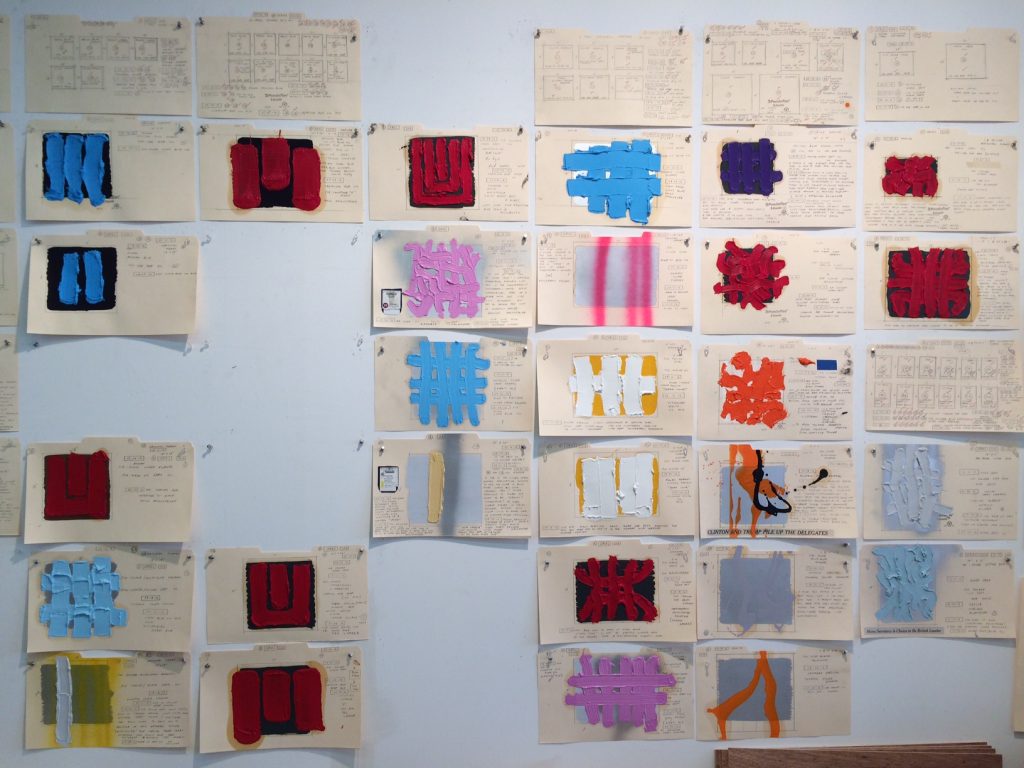
Contributed by Sharon Butler / Two Coats of Paint recently stopped in at John Zinsser‘s sunny Greenpoint studio. Zinsser moved to New York in the ’80s and has been making mostly-monochromatic, rule-based abstract paintings ever since. During our visit we talked about his Dedalus Foundation exhibition, “The Humanism of Abstraction,” which also includes work by David Reed and Carrie Moyer. Robert Motherwell, who established Dedalus in 1981, would certainly appreciate Zinsser’s approach to painting, as it is akin to Motherwell�s. In an interview with Cindi Di Marzo, Zinsser said, “My work relies foremost on sheer visuality, the belief that a painting, under the right self-imposed confining circumstances, might ‘show you something,’ something that you didn’t know that you knew. �
Aligning his practice with conceptual approaches of artists like Carl Ostendarp and Dan Walsh, Zinsser is deeply committed to exploring, but not crossing, the boundaries of painting. In fact, Zinsser told me that a painting must be made on stretched canvas, otherwise it is something else entirely. His sense of humor is so dry, I wasn�t sure whether he was kidding.

For Zinsser, the painting process begins with annotated painted studies on unprimed legal-size file folders. In one corner of the studio, there is a stack of clear plastic containers full of them. The most recent ones hang on the walls so he can assess the new painting strategies each suggests.
Once he decides on the strategy, Zinsser allows for some flexibility in the painting process while also broadly adhering to the guidelines he has established on the folder study. He prefers to complete each painting in one go, which means either they work or he starts over. He intensely enjoys contemplating painting tropes, teasing out the clich�d meaning in painterly incidents like drips, spills, and spatter.

Playfulness and improvisation, then, are parts of the process but within fairly strict, self-imposed limits. For instance, in most of his work, a layer of brushstrokes or patterning overlies a layer of base color. But for Zinsser, the brushstroke can�t simply be a mark; he understands it and utilizes it as an iconic figure in the history of art.





Zinsser writes criticism, makes artists� books, and teaches a course in contemporary art at The New School. He must be a terrific lecturer because he sees a lot of art, has estimable command of the painting tradition, and likes to spin a good yarn. The artist’s book he showed me incorporated all three sensibilities–it was an irreverent homage to painters he admires. Zinsser is a fanatic for art history, and his work is first and foremost about painting itself. The game is best when a studied literalness jousts for position with the more innocent urge simply to make a picture.
“The Humanism of Abstraction,” curated by Industry City and the Dedalus Foundation. The Gallery at Industry City, Sunset Park, Brooklyn, NY. Through November 17. With work by John Zinsser, Carrie Moyer, and David Reed.
Related Posts:
Interview: Carrie Moyer in Long Island City
David Reed: A painter’s life
Recto or Verso: what kind of artist are you?


















Dear Ms. Butler,
I enjoyed seeing the studio practice and the work and process of John Zinsser. Your text is helpful in understanding how and why the paintings are the way they are.
Thank you for providing this personal view.
Rainer Gross